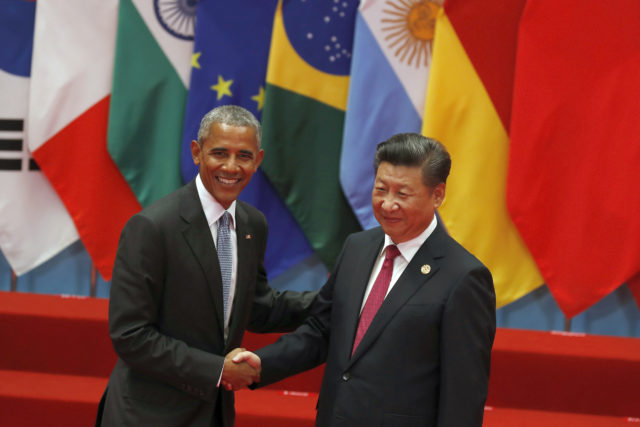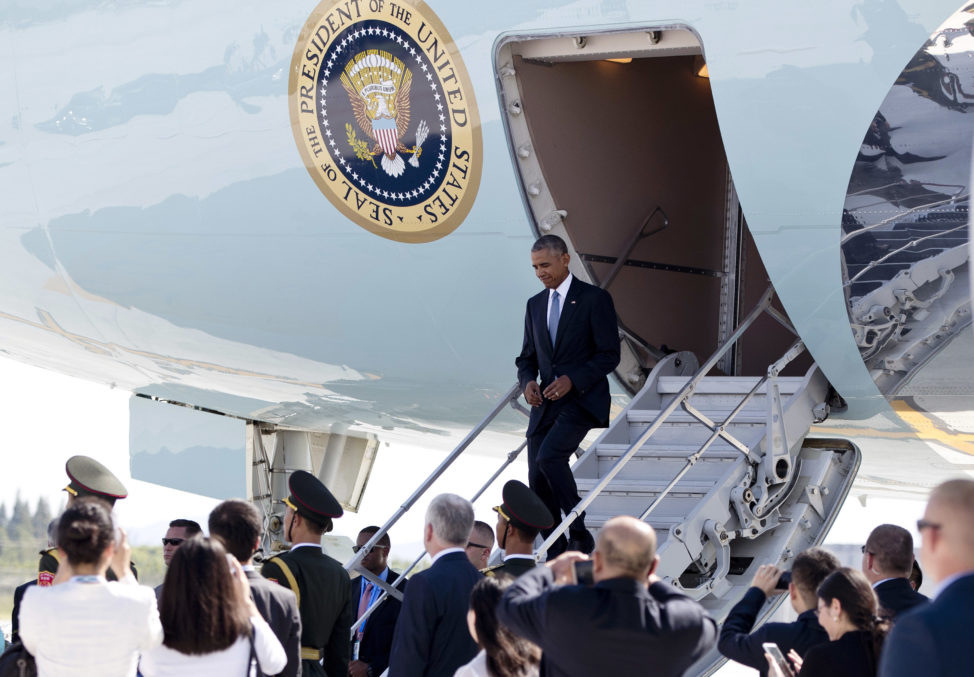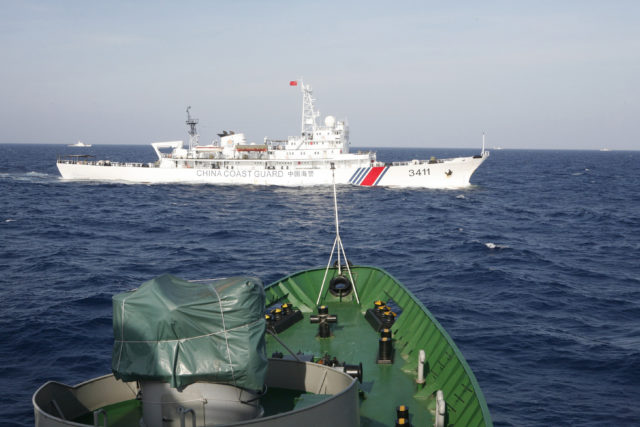
U.S. President Barack Obama, left, shakes hands with China’s President Xi Jinping before a group photo session for the G20 Summit in Hangzhou in eastern China’s Zhejiang province, Sept. 4, 2016. (AP)
Barack Obama’s tenth and final trip to Asia was billed as an opportunity to demonstrate the how the “centerpiece” of U.S. foreign policy is the “rebalance” to the Asia-Pacific region.
Obama has been trying to pivot to Asia for much of his time in the White House, but events in the Middle East and Europe have drawn an extraordinary amount of attention.
Trade, climate change and the situation in the South China Sea sat atop his agenda. But attention has again been diverted by a perceived slight by China, a slur by the Philippines president and doubts that Obama can get the Trans Pacific Partnership trade deal passed by Congress.
For all the time and effort Obama has put into pivoting to Asia, how much will have to be left for the next president?
The Unfinished Legacy of Obama’s Pivot to Asia
Victor Cha – Foreign Policy
Presidencies are remembered not for their plans coming into the Oval Office, but for how they react to the surprises thrown their way. In this regard, Obama responded with worthy midcourse adjustments. The White House’s critical but unseen coordination with the Japanese government during the Fukushima meltdown, followed by the more public Operation Tomodachi recovery project…helped to restore the reservoir of trust in the alliance. In North Korea, Obama transitioned from engagement to containment, helping to erect a comprehensive multilateral sanctions regime….he demonstrated positive and historic diplomatic advances with Myanmar, Vietnam, and Laos.
The White House elevated relations with other partners like South Korea and Australia, both of whom were willing to contribute on signature Obama projects like climate change, nuclear security, and global health….
As much as the administration would like to take a victory lap in Asia, the legacy of the pivot is only partially complete. And it is on the China account where there remains much work.
What Are the U.S. and China Fighting Over?
Fu Ying – Bloomberg View
In fact, the U.S. views frictions with China from a geo-strategic perspective, seeing the South China Sea dispute as a test of which power will predominate in the Asia-Pacific. Ever since U.S. leaders started talking about a “pivot” or “rebalance” to Asia, they’ve worked under the assumption that a stronger China will inevitably pursue expansionism — and thus needs to be countered by the U.S. and its allies.
Against this background, any move by China naturally looks like an attempt to weaken U.S. strategic primacy in the region. And at the same time, American rhetoric and activities clearly targeted at China are bound to trigger a strong Chinese reaction….
There’s room for both China and the U.S. to manage their relations better. The U.S. lacks experience in dealing with powers that are “neither ally nor foe,” while China has never interacted with the world’s superpower from a position of strength.

President Barack Obama arrives on Air Force One at Hangzhou Xiaoshan International Airport in Hangzhou in eastern China’s Zhejiang province, Saturday, Sept. 3, 2016. Some perceived it as a slight to Obama that airplane stairs and a red carpet were not made available for the U.S. president. (AP)
What’s Behind Obama’s Stairgate?
Max Boot – Commentary
[E]ven as China has become the go-to producer of electronics and lots of other goods, its No. 1 manufacturing industry has remained the same: It specializes in producing chips for shoulders. Specifically chips for the shoulders of Chinese people who are constantly reminded of the humiliation they have suffered in the past at the hands of Americans, Europeans, and Japanese….
Hence Chinese jubilation over a petty slight to the president of the United States and to a bigger and more significant slight to China’s neighbors and the rule of law in the South China Sea. The Chinese anger and pride is real but it is also kept at a fever-pitch by Xi Jinping and the ruling Politburo.
Barack Obama Is Now Alone in Washington
Fareed Zakaria – The Washington Post
The direct purpose of his trip to China is to attend a meeting of the Group of 20, but perhaps more importantly, the visit is intended to breathe life into one of his big ideas: the pivot to Asia. It is a genuinely important policy, but Obama is now the last man standing willing to push for it.
Foreign policy is consumed with momentary crises — often created by failing states and violent groups. But in the long run, the future is shaped by winners, not noisy losers. And when the flash points of today have passed, the rise of Asia will remain the dominant trend of our time….
How should Washington approach this region? One central task is obviously to prevent China from dominating it….
But Washington’s policy is not containment. It can’t be.
How Xi and Putin Humiliated Obama at the G-20
Anders Åslund – Atlantic Council
As chairman, Xi took the privilege to steamroll his poor guests, claiming that the G-20 had overtaken the G-7 of the democratic industrial states. Since the G-20 meeting is not relevant, while many important people had gathered, the bilateral meetings dominated the news cycle. Xi took the lead in this game. By contrast, Obama had only three official bilateral meetings…
The surprise was the rookie, Vladimir Putin. In Brisbane in 2014, he had been the outcast because of his military aggression against Ukraine. Hangzhou marked his homecoming, where he broke his international isolation without changing his behavior.
Is Naval Conflict with China Inevitable?
Seth Cropsey – Real Clear Defense
A ship (top) of Chinese Coast Guard is seen near a ship of Vietnam Marine Guard in the South China Sea, about 210 km (130 miles) off shore of Vietnam May 14, 2014. Vietnamese ships were followed by Chinese vessels as they neared China’s oil rig in disputed waters in the South China Sea on Wednesday, Vietnam’s Coast Guard said. Vietnam has condemned as illegal the operation of a Chinese deepwater drilling rig in what Vietnam says is its territorial water in the South China Sea. (Reuters)
U.S. policy toward China has failed spectacularly. China’s actions show that it sees us as a strategic competitor. We have chosen to see China as a large market that can be cajoled into joining us as a defender of international security and economic stability….
The next U.S. administration needs to understand that our fate as a great power is inseparable from America’s continued role as a great Pacific power. This does not mean aggressive policies or military confrontation. It does mean active diplomacy with the nations on China’s periphery who fear its hegemony. It means credible combat power to foreshorten China’s mis-behavior and militarized ambitions, including consistent, reliable, and frequent U.S. Navy freedom of navigation operations in the international waters of the South China Sea….


